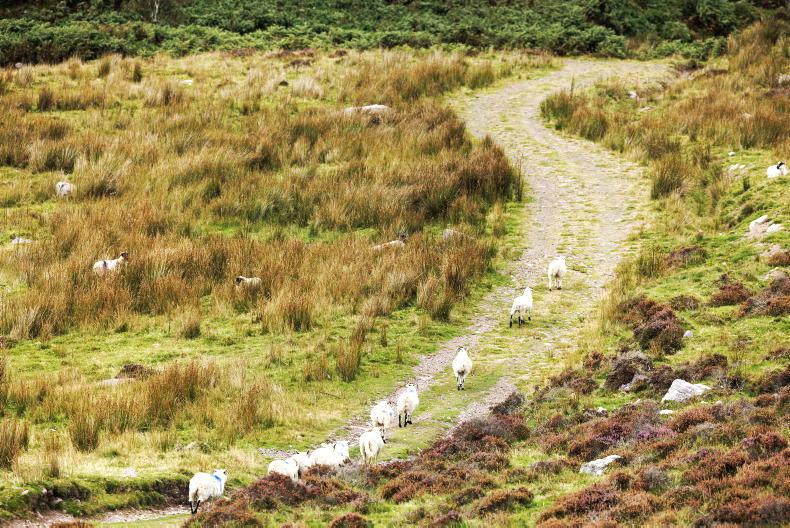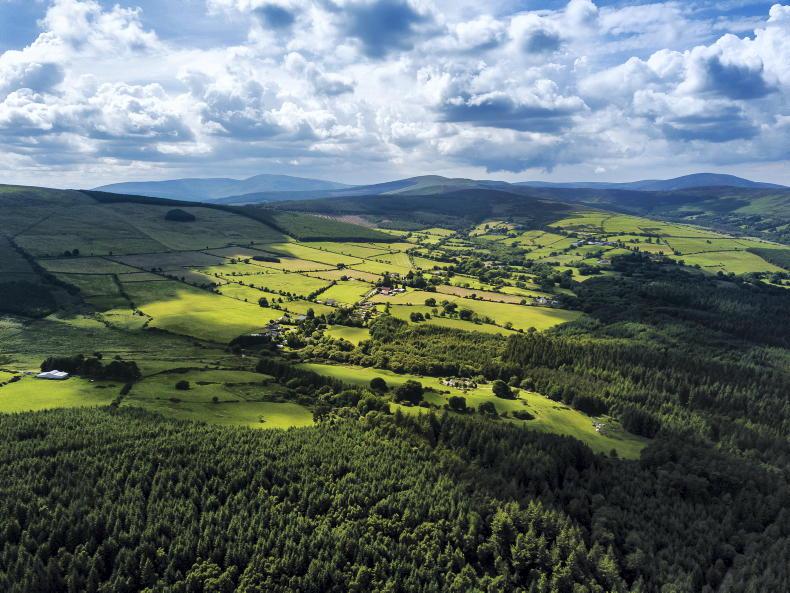The CAP Strategic Plan 2023-2027 officially came into play on 1 January. The new regime will mean changes for all farmers, irrespective of their farm type, size and location. The level of funding remains broadly the same but the manner in which almost €1.2bn in annual Pillar I funding will be paid has experienced possibly the greatest change.
All entitlement values are changing
Entitlement values under the last CAP had an environmental component, which accounted for 44% of the overall value of an entitlement.
A high percentage of farmers qualified without having to make any real change to their business and, as such, the concept went largely under the radar.
The changes in the new CAP will not fly under the radar as easily, with entitlement values subject to the main changes as summarised briefly below.
Some 25% of the direct payment fund (€593m) will be ringfenced to fund the eco scheme, the new environmental scheme within Pillar 1. Payment levels will be influenced by the level of participation, which is voluntary.
It is thought that in the region of 92% to 93% of farmers will satisfy the two required agricultural practices via a measure known as space for nature with most farmers receiving a maximum payment of approximately €64 to €66 per hectare.
Payment is independent of entitlements, meaning all eligible hectares are entitled to a payment.
The complementary redistributive income support for sustainability is commonly known as CRISS or frontloading. The funding of approximately €118m per annum has been derived by ringfencing 10% of the annual budget.
As the name suggests, the payment will be frontloaded on the first 30ha of eligible ground. It is paid largely independent of payment entitlements, with one entitlement required to activate the payment. This is expected to be in the region of €43/ha, with some farmers benefiting while others will contribute significantly to the fund.
The Complementary Income Support for Young Farmers (CISYF) will see another 3% of the direct payments ceiling or approximately €35m being allocated annually to a young farmers’ scheme.
The payment rate is in the region of €170/ha for up to five years on 50ha with no guarantees as to the payment rate beyond 2027. This is no longer based on entitlements and instead is based on eligible hectares.
The Basic Income Support for Sustainability (BISS) replaces the entitlement aspect of the Basic Payment Scheme.
It is the new entitlement value minus a further 3% for a national reserve fund.

The Basic Income Support for Sustainability (BISS) replaces the entitlement aspect of the Basic Payment Scheme. \ Donal O'Leary
Entitlements will be subject to convergence and the rate is increasing from 60% to 85%, with deductions or increases to entitlement values taking place in equal steps, reaching a minimum of 85% by 2026.
By 2026, all entitlements will fall into a range of €125 to €285 per unit, with the new average being around the €155 per unit mark.
National reserve
The national reserve will have a fund of €7m annually. It will be open to young trained farmers and new farmers. These are classified as those who have set up a holding for the first time or during the three years preceding the first submission of a national reserve application. New farmers will also require the same educational requirements as young farmers.

The complementary redistributive income support for sustainability is commonly known as CRISS or frontloading. \ Philip Doyle
Trading of entitlements
The changes above are not the only ones linked to entitlements.
The Department is obliged to continue to offer a mechanism for trading of entitlements. This will open for applications in mid-March, with farmers told at the start of March that entitlements statements will be provided “in the coming weeks”.
Amnesty: an important component introduced for 2023 and 2024 is an amnesty on clawback on the sale of entitlements without lands. In the current CAP, the sale of entitlements without lands was subject to clawback at 20%. This meant that for every 10 entitlements traded, the value of two entitlements would be relinquished to the national reserve. As it stands, the 20% clawback rule on the sale of entitlements without land will return in 2025 and be present again in 2026 and 2027.
Beneficial features: features such as scrub, trees, woodland, habitat and rock which are deemed to be delivering a biodiversity benefit may now be deemed eligible for the purpose of receiving your BISS, eco-scheme payments, etc. These beneficial features can now comprise up to 50% of the reference area of that parcel (minus deductions for any artificial features such as roads, buildings and waterbodies) and be deemed eligible for payment.
Active farmer
From 2023, every farmer will be required to satisfy an active farmer definition. For grassland farmers, this will typically be a minimum stocking rate of 0.1LU/ha while farmers with crops may be asked to present proof of activity and those without livestock or crops will be asked to prove they are maintaining lands in a manner which is providing an environmental benefit.
Existing and new leases
The new CAP measures can have a major effect on existing leases. The advice is to be crystal clear on the amounts of money changing hands and any longer-term leases beyond 2027 should include a mandate to cater for subsequent changes.
All of these change have the potential to greatly influence the sale and leasing of entitlements for the next five years.
The CAP Strategic Plan 2023-2027 officially came into play on 1 January. The new regime will mean changes for all farmers, irrespective of their farm type, size and location. The level of funding remains broadly the same but the manner in which almost €1.2bn in annual Pillar I funding will be paid has experienced possibly the greatest change.
All entitlement values are changing
Entitlement values under the last CAP had an environmental component, which accounted for 44% of the overall value of an entitlement.
A high percentage of farmers qualified without having to make any real change to their business and, as such, the concept went largely under the radar.
The changes in the new CAP will not fly under the radar as easily, with entitlement values subject to the main changes as summarised briefly below.
Some 25% of the direct payment fund (€593m) will be ringfenced to fund the eco scheme, the new environmental scheme within Pillar 1. Payment levels will be influenced by the level of participation, which is voluntary.
It is thought that in the region of 92% to 93% of farmers will satisfy the two required agricultural practices via a measure known as space for nature with most farmers receiving a maximum payment of approximately €64 to €66 per hectare.
Payment is independent of entitlements, meaning all eligible hectares are entitled to a payment.
The complementary redistributive income support for sustainability is commonly known as CRISS or frontloading. The funding of approximately €118m per annum has been derived by ringfencing 10% of the annual budget.
As the name suggests, the payment will be frontloaded on the first 30ha of eligible ground. It is paid largely independent of payment entitlements, with one entitlement required to activate the payment. This is expected to be in the region of €43/ha, with some farmers benefiting while others will contribute significantly to the fund.
The Complementary Income Support for Young Farmers (CISYF) will see another 3% of the direct payments ceiling or approximately €35m being allocated annually to a young farmers’ scheme.
The payment rate is in the region of €170/ha for up to five years on 50ha with no guarantees as to the payment rate beyond 2027. This is no longer based on entitlements and instead is based on eligible hectares.
The Basic Income Support for Sustainability (BISS) replaces the entitlement aspect of the Basic Payment Scheme.
It is the new entitlement value minus a further 3% for a national reserve fund.

The Basic Income Support for Sustainability (BISS) replaces the entitlement aspect of the Basic Payment Scheme. \ Donal O'Leary
Entitlements will be subject to convergence and the rate is increasing from 60% to 85%, with deductions or increases to entitlement values taking place in equal steps, reaching a minimum of 85% by 2026.
By 2026, all entitlements will fall into a range of €125 to €285 per unit, with the new average being around the €155 per unit mark.
National reserve
The national reserve will have a fund of €7m annually. It will be open to young trained farmers and new farmers. These are classified as those who have set up a holding for the first time or during the three years preceding the first submission of a national reserve application. New farmers will also require the same educational requirements as young farmers.

The complementary redistributive income support for sustainability is commonly known as CRISS or frontloading. \ Philip Doyle
Trading of entitlements
The changes above are not the only ones linked to entitlements.
The Department is obliged to continue to offer a mechanism for trading of entitlements. This will open for applications in mid-March, with farmers told at the start of March that entitlements statements will be provided “in the coming weeks”.
Amnesty: an important component introduced for 2023 and 2024 is an amnesty on clawback on the sale of entitlements without lands. In the current CAP, the sale of entitlements without lands was subject to clawback at 20%. This meant that for every 10 entitlements traded, the value of two entitlements would be relinquished to the national reserve. As it stands, the 20% clawback rule on the sale of entitlements without land will return in 2025 and be present again in 2026 and 2027.
Beneficial features: features such as scrub, trees, woodland, habitat and rock which are deemed to be delivering a biodiversity benefit may now be deemed eligible for the purpose of receiving your BISS, eco-scheme payments, etc. These beneficial features can now comprise up to 50% of the reference area of that parcel (minus deductions for any artificial features such as roads, buildings and waterbodies) and be deemed eligible for payment.
Active farmer
From 2023, every farmer will be required to satisfy an active farmer definition. For grassland farmers, this will typically be a minimum stocking rate of 0.1LU/ha while farmers with crops may be asked to present proof of activity and those without livestock or crops will be asked to prove they are maintaining lands in a manner which is providing an environmental benefit.
Existing and new leases
The new CAP measures can have a major effect on existing leases. The advice is to be crystal clear on the amounts of money changing hands and any longer-term leases beyond 2027 should include a mandate to cater for subsequent changes.
All of these change have the potential to greatly influence the sale and leasing of entitlements for the next five years.








 This is a subscriber-only article
This is a subscriber-only article










SHARING OPTIONS: